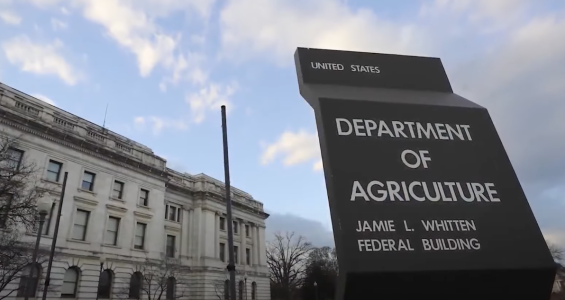Empty shelves ahead? Concerns grow over recent budget changes
- Replies 0
The fabric of America's food security is fraying as recent federal cuts threaten to leave a gaping hole in the nation's safety net.
Food banks and farmers alike are sounding the alarm, warning of a looming crisis that could leave thousands of our fellow citizens facing hunger.
Let's delve into the details of these cuts and explore the potential impact on our communities, as well as what steps can be taken to mitigate the fallout.
The sudden withdrawal of federal funding for key programs supporting food banks is being felt nationwide, as many already under-resourced organizations are now appealing to their local communities for support.
In early March, the US Department of Agriculture announced it would slash more than $1 billion in funding for the 2025 cycle of two major initiatives: the Local Food for Schools Cooperative Agreement and the Local Food Purchase Assistance Cooperative Agreement programs.
These funds had been used to pay farmers to supply food to schools and food banks—benefiting both local producers and underserved communities by providing fresh, healthy food.
Soon after, food banks were dealt another setback when they were notified that planned food deliveries through the USDA’s Emergency Food Assistance Program would be reduced or halted altogether.

“The reality is that the food banking system is stressed to the breaking point right now because we're seeing record-high demand and diminished resources,” Vince Hall told USA TODAY.
“Folks who came to us during the pandemic have found it impossible to ease out of dependency on food banks because inflation has made so many of their monthly budget essentials more expensive than ever.”
With federal funding gone, food banks are now turning to local communities for help.
In states like Iowa, Arizona, and Delaware, millions of dollars in funding for schoolchildren and food assistance programs have been cut—$11.3 million in Iowa, $21 million in Arizona, and about $2 million in Delaware.
In Delaware, the Food Bank was notified that nearly 900,000 meals slated for delivery through the USDA’s Emergency Food Assistance Program would no longer be arriving, cutting off more than a quarter of their expected supply for the year.
“The stress level is going up,” said Anne Hayes, executive director of Gather food pantry in Portsmouth, New Hampshire. “What I would say is, the government is stepping back, clearly, so we need the community to step up.”
According to Hall, food banks typically source their supplies in three ways: direct donations from communities or food producers, government programs like those from the USDA, and food they purchase using their own limited budgets.
With the loss of federal assistance, they’ll need to depend even more on local donations—which is especially difficult in rural areas, he added.

“There’s going to be a lot of hungry people,” said Matt Habash, CEO of The Mid-Ohio Food Collective, following news that the USDA was slashing more than $1 billion from the Local Food for Schools and Local Food Purchase Assistance programs for 2025. “It's just going to be less food available for people that need it now.”
To compensate, the USDA has turned to Section 32 of the Agricultural Adjustment Act to purchase food and replenish some of what was lost, Hall said. But that effort only replaces a portion of the more than $1 billion cut.
While the food bank system struggles to keep up with demand, Hall said he’s optimistic that Congress will include funding for these programs in the upcoming Farm Bill.
For farmers and food producers, the shakeup has been equally painful.
The Local Food Purchase Assistance program was created to support small and local farms while also addressing COVID-era supply chain disruptions. Now, those farmers say the funding loss has put their livelihoods in jeopardy.
“For Iowa farmers, the impact is immediate and potentially devastating,” said the Iowa Farmers Union in a statement to the Des Moines Register. “Producers who have already planned over $3 million in food sales in 2025 through these programs now face sudden financial uncertainty.”
Chris Schwartz, who leads the Iowa Food System Coalition, warned the loss in funding could push small farmers into bankruptcy.
In Arizona, food banks may be forced to stop providing locally sourced food, according to both organizations and farmers.
Source: CBS News / Youtube.
“They've been an incredible resource for farmers to create different retail outlets for the things that they grow. So to shut that off abruptly, the ripple effects are quite drastic,” said Jessie Gruner, director of community innovations at Pinnacle Prevention, to the Arizona Republic.
Kristy Allen, a beekeeper in Wisconsin and owner of the Bees Kneez in Burnett County, told the Milwaukee Journal Sentinel that the funding enabled her to deliver about 3,000 pounds of honey to the St. Croix Valley Food Bank.
It also allowed her to hire a part-time employee—an expense she now fears she won’t be able to sustain.
The loss of the cooperative agreement programs also means schools will have a harder time providing healthy meals to students, said Julie Udelhofen, a school food service director in northern Iowa.
“Schools won’t be able to serve fresh, nutrient-dense fruits and vegetables that encourage lifelong healthy eating,” she told the Des Moines Register.
Locally sourced produce doesn’t just taste better—it’s more nutritious and has a longer shelf life than items shipped across state lines, said Kelly Saxon, farm head at Agritopia Farm in Gilbert, Arizona.
“I was really excited when we became part of this program,” Saxon said to the Arizona Republic. “As a taxpayer, I'm OK with my money going to do that.”

Have you or someone you know been affected by these cuts? Do you have ideas for how communities can come together to address food insecurity? Share your thoughts and experiences in the comments below!
Food banks and farmers alike are sounding the alarm, warning of a looming crisis that could leave thousands of our fellow citizens facing hunger.
Let's delve into the details of these cuts and explore the potential impact on our communities, as well as what steps can be taken to mitigate the fallout.
The sudden withdrawal of federal funding for key programs supporting food banks is being felt nationwide, as many already under-resourced organizations are now appealing to their local communities for support.
In early March, the US Department of Agriculture announced it would slash more than $1 billion in funding for the 2025 cycle of two major initiatives: the Local Food for Schools Cooperative Agreement and the Local Food Purchase Assistance Cooperative Agreement programs.
These funds had been used to pay farmers to supply food to schools and food banks—benefiting both local producers and underserved communities by providing fresh, healthy food.
Soon after, food banks were dealt another setback when they were notified that planned food deliveries through the USDA’s Emergency Food Assistance Program would be reduced or halted altogether.

The US Department of Agriculture announced significant funding cuts for programs that help food banks distribute healthy, local food, affecting food banks and farmers across the country. Image source: WGN News / Youtube.
“The reality is that the food banking system is stressed to the breaking point right now because we're seeing record-high demand and diminished resources,” Vince Hall told USA TODAY.
“Folks who came to us during the pandemic have found it impossible to ease out of dependency on food banks because inflation has made so many of their monthly budget essentials more expensive than ever.”
With federal funding gone, food banks are now turning to local communities for help.
In states like Iowa, Arizona, and Delaware, millions of dollars in funding for schoolchildren and food assistance programs have been cut—$11.3 million in Iowa, $21 million in Arizona, and about $2 million in Delaware.
In Delaware, the Food Bank was notified that nearly 900,000 meals slated for delivery through the USDA’s Emergency Food Assistance Program would no longer be arriving, cutting off more than a quarter of their expected supply for the year.
“The stress level is going up,” said Anne Hayes, executive director of Gather food pantry in Portsmouth, New Hampshire. “What I would say is, the government is stepping back, clearly, so we need the community to step up.”
According to Hall, food banks typically source their supplies in three ways: direct donations from communities or food producers, government programs like those from the USDA, and food they purchase using their own limited budgets.
With the loss of federal assistance, they’ll need to depend even more on local donations—which is especially difficult in rural areas, he added.

Food banks and farmers decry the federal cuts, as many organizations face increased stress and potential financial uncertainties with the loss of funding. Image source: WGN News / Youtube.
“There’s going to be a lot of hungry people,” said Matt Habash, CEO of The Mid-Ohio Food Collective, following news that the USDA was slashing more than $1 billion from the Local Food for Schools and Local Food Purchase Assistance programs for 2025. “It's just going to be less food available for people that need it now.”
To compensate, the USDA has turned to Section 32 of the Agricultural Adjustment Act to purchase food and replenish some of what was lost, Hall said. But that effort only replaces a portion of the more than $1 billion cut.
While the food bank system struggles to keep up with demand, Hall said he’s optimistic that Congress will include funding for these programs in the upcoming Farm Bill.
For farmers and food producers, the shakeup has been equally painful.
The Local Food Purchase Assistance program was created to support small and local farms while also addressing COVID-era supply chain disruptions. Now, those farmers say the funding loss has put their livelihoods in jeopardy.
“For Iowa farmers, the impact is immediate and potentially devastating,” said the Iowa Farmers Union in a statement to the Des Moines Register. “Producers who have already planned over $3 million in food sales in 2025 through these programs now face sudden financial uncertainty.”
Chris Schwartz, who leads the Iowa Food System Coalition, warned the loss in funding could push small farmers into bankruptcy.
In Arizona, food banks may be forced to stop providing locally sourced food, according to both organizations and farmers.
Source: CBS News / Youtube.
“They've been an incredible resource for farmers to create different retail outlets for the things that they grow. So to shut that off abruptly, the ripple effects are quite drastic,” said Jessie Gruner, director of community innovations at Pinnacle Prevention, to the Arizona Republic.
Kristy Allen, a beekeeper in Wisconsin and owner of the Bees Kneez in Burnett County, told the Milwaukee Journal Sentinel that the funding enabled her to deliver about 3,000 pounds of honey to the St. Croix Valley Food Bank.
It also allowed her to hire a part-time employee—an expense she now fears she won’t be able to sustain.
The loss of the cooperative agreement programs also means schools will have a harder time providing healthy meals to students, said Julie Udelhofen, a school food service director in northern Iowa.
“Schools won’t be able to serve fresh, nutrient-dense fruits and vegetables that encourage lifelong healthy eating,” she told the Des Moines Register.
Locally sourced produce doesn’t just taste better—it’s more nutritious and has a longer shelf life than items shipped across state lines, said Kelly Saxon, farm head at Agritopia Farm in Gilbert, Arizona.
“I was really excited when we became part of this program,” Saxon said to the Arizona Republic. “As a taxpayer, I'm OK with my money going to do that.”
Key Takeaways
- The US Department of Agriculture announced significant funding cuts for programs that help food banks distribute healthy, local food, affecting food banks and farmers across the country.
- Food banks and farmers decry the federal cuts, as many organizations face increased stress and potential financial uncertainties with the loss of funding.
- The cuts will particularly impact rural communities that heavily rely on USDA-funded programs, leading to a potential increase in hunger among these populations.
- While food banks may turn to community donations to fill the gap, the cessation of federal funding will likely lead to less locally grown, fresh food being available for those in need.
Have you or someone you know been affected by these cuts? Do you have ideas for how communities can come together to address food insecurity? Share your thoughts and experiences in the comments below!






